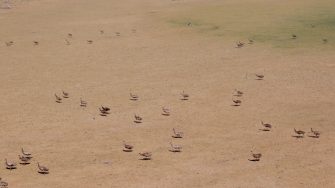
Date: Tuesday, October 17, 2017
Project: Eastern Australian Waterbird Survey
Observer: Richard Kingsford
I always look forward to seeing the country from the air each year, even though I have been doing this for over 30 years. It’s great to see the natural fluctuations of the rivers and landscapes and tracking our impacts, positive and negative over. New survey team this week – Kingsford and Ewin. We try to give people a break, as the surveying is taxing. We headed out west from Sydney over a partly cloudy and hazy Sydney, with low clouds hugging the Blue Mountains to our first survey point – Burrendong Dam.
Photo – Burrendong Dam regulates flows in the Macquarie River
This dam is just north of Wellington and it regulates water in the Macquarie River, capturing floods and storing them for towns downstream, irrigation (most use) and the river and Macquarie Marshes. Our years of research have demonstrated that the dam and diversions downstream have had major impacts on the flows and flooding downstream, reducing the size and frequency of bird breeding events and degrading the floodplain vegetation. If you want to read more about the science, you can find the peer reviewed papers on the Macquarie Marshes which tell this story https://scholar.google.com.au/citations?user=sUHBkSIAAAAJ&hl=en
The dam was drying back but still 70 % full. Occasionally the dam has quite a few waterbirds but not what you would expect for this expanse of water. The water is generally too deep and unproductive for invertebrates and plants which fish and many waterbird species eat. There are always a few fish-eating birds – pelicans and comorants. Today there were a few hundred wood ducks as well, brought in by the dry areas to graze on the green grass on the exposed banks of the dam.
From here – along the Macquarie River to refuel at Dubbo. Then after a break, the long flight out west, along band 4 all the way to Broken Hill. There are a few temporary wetlands and farm dams before we get out to the Darling River floodplain. As predicted in this dry year, they were nearly all dry. It can be busy along this survey band but only when there is good local rain.
Photo – Surveying the drying Menindee Lakes
The first real excitement for waterbird counters can come when you get to big temporary lakes of the Tallywalka Creek system, which floods from the Darling River in large floods. The last time they had water was during the 2010 floods. Not unexpectedly, they were all dry. Then on to Menindee Lakes which were predictably busy with birds.
Menindee Lakes are highly productive as they dry back, exposing lots of shallow habitat
We had to work hard. These lakes were drying back and shallow, exposing the best habitats for waterbirds of every species from thousands of pelicans to migratory shorebirds which have winged their way from their Russian and Chinese breeding grounds.
They didn’t disappoint today. We were flat out counting thousands of waterbirds. There were the fish-eating birds, the cormorants, pelicans, darters and herbivorous birds like swans and coot. And then lots of different duck species. It is also great to see so many wading birds. We do two counts of all the lakes which makes for a long day.
Menindee Lake was only about half full and had thousands of waterbird, capitalising on all the food available.
This is the site for proposed major works to make the system more efficient by saving water that is currently evaporating. There is a real opportunity here for a win win. The lakes have always had too much water which has killed vegetation and made them poor habitat, not just for waterbirds but most aquatic organisms adapted to the boom and bust of Australian rivers. It would be great if we could reinstate the drying and filling patterns of the past before the lakes were regulated with a dam.
The worry is that decision-makers are racing to get all the water out of these lakes to save water for the environment and ignoring this wonderful ecosystem. Nearly 30% of it is in Kinchega National Park. We have an obligation to protect its values. This means of course not thinking that all water needs to be removed from the lakes as soon as possible. And it certainly shouldn’t mean drying up Lake Cawndilla in Kinchega National Park which seems to be one proposed idea. It would be great to see the lakes restored to their historic value and it could be done. It would also be great for tourism. Another major challenge is the dwindling water supply down the Darling, diverted upstream for irrigation, considerably reducing flows to the lakes.
The drying lake beds are green with grass for Emu flocks
